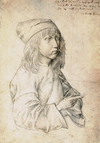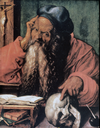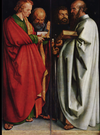N Renaissance Painting Exam 2 Flashcards
(63 cards)

Before Christ Herod
woodcut
ca. 1400
_____
- artist had to cut all of the white areas
- similar works are all very simple in detail and form due to the amount of cutting that had to be done
- no indication of setting

Master of the Playing Cards
King of the Wild Men
engraving
ca. 1440s
_____
- also popular, secular items that were made from prints
- uses more lines to define the image
- quite a variety of strokes

Master E.S.
Einsiedeln Madonna
engraving
1466
_____
- very elaborate image
- probably made to commemorate the 500th anniversary of a chapel dedicated to the virgin mary

Master E.S.
Samson and Delilah
engraving
ca. 1460
_____
- prints not generally commissioned by a patron
- printmakers had more artistic freedom

Martin Schongauer
Nativity
engraving
1470-75
_____
- quite a lot of detail in Mary’s drapery
- inspired by paintings of the subject, which Martin used for reference

Martin Schongauer
Flight into Egypt
engraving
ca. 1470-75
_____
- so detailed…showing bark in the trees, shadows giving depth from background to foreground
- achieved through an inventive approach to composition and his versatility as an artist

Martin Schongauer
Temptation of St. Anthony
engraving
ca. 1470-75
_____
- his most famous engraving
- he zeroes in on the figure, surrounding him with a variety of demons
- has incredible control of stroke
- varying weight, length and spacing of his lines in order to get his iconography across

Martin Schongauer
Death of the Virgin
engraving
ca. 1470-75
_____
- monogram is prominent at the bottom
- so complex, very elaborate candle stick in the foreground
- carefully included a variety of emotions and sense of perspective/space

Martin Schongauer
The Road to Calvary
engraving
ca. 1475
_____
- very ambitious in terms of scale and complexity
- variety of strokes to capture the essance of light
- great example of light lights and dark darks…depth

Israhel van Mekenem the Younger
Self-Portrait with his Wife Ida
engraving
ca. 1490
_____
- most prolific of all 15th century german engravers, clocking in at over 600 different engravings…very very active
- first engraver as we know to create a self portrait
- indication of print making moving up the ladder as something with more value

Israhel van Meckenem
Mismatched Lovers
engraving
_____
- shows a large age difference between the lovers, wouldn’t normally be acceptable in paintings, but is more common in engravings

Master of the Amsterdam Cabinet
Aristotle and Phyllis
drypoint
ca. 1480
_____
- example of a secular themed work

Tilman Riemenschneider
Passion Altarpiece
[details of mourning women, St. John, Caiaphas, and Soldiers]
painted limewood
Munich
1485-90
_____
- became an independent master
- important stylistic features: lots of emotion with faces and posing
- very detailed drapery on the clothing - you can tell there’s a body beneath the clothing
- complex arrangement of folds

Tilman Riemenschneider
Munnerstadt Altarpiece
[with details of the 4 Evangelists]
limewood
Munnerstadt, Church of Mary Magdalen
1492
_____
- all documents still survive
- a commission for the church of Mary Magdalen
- small but prosperous town
- built in a gothic church
- the iconography was supposed to center on Mary Magdalen, the patron saint of the church
- she is centered, flanked by two local saints
- four evangelists down below
- reliefs from her life are at the side
- she is ascending to heaven in this depiction, being carried up by all the little angels

Tilman Riemenschneider
Munnerstadt Altarpiece
[detail: Mary Magdalen]
1492
_____
- the iconography was supposed to center on Mary Magdalen, the patron saint of the church
- she is centered, flanked by two local saints
- four evangelists down below
- reliefs from her life are at the side
- she is ascending to heaven in this depiction, being carried up by all the little angels

Tilman Riemenschneider
Madonna and Child on a crescent moon
painted limewood
Vienna
ca. 1505-10

Tilman Riemenschneider
Holy Blood Altarpiece
limewood
1501-05
_____
- in the chapel of the Holy Blood, named for the most famous relic that the church owns, a drop of Christ’s blood
- the iconography is driven by the identity of the relic
- the central subject is the last supper, when Christ establishes the sacrament of the Eucharist

Tilman Riemenschneider
Holy Blood Altarpiece [detail]
limewood
1501-05
_____
- in the chapel of the Holy Blood, named for the most famous relic that the church owns, a drop of Christ’s blood
- the iconography is driven by the identity of the relic
- the central subject is the last supper, when Christ establishes the sacrament of the Eucharist

Albrecht Dürer
Self-Portrait Drawing at 13
silverpoint
1484
_____
- the earliest he created
- a silverpoint drawing
- first artist to sign and date many of his drawings
- went back through much later and inscribed his drawings

Albrecht Dürer
Self-Portrait with Eryngium
Louvre
1493
_____
- painted his portrait in the context of his marriage arrangement/engagement
- fancy clothing, looking his “best”
- holding a flower that was considered to be symbolic of “luck in love”

Albrecht Dürer
Dürer’s Mother
black chalk drawing
1514
_____
- black chalk drawing…single medium
- forehead wrinkles are really fine lines, with contrasting deep shadows
- very detailed, but unidealized portrait of an older woman

Albrecht Dürer
Self-Portrait
1498
_____
- here he is morphed into a total dandy
- beautiful curly hair, dressed in the italian style
- uses an italian format for the composition

Albrecht Dürer
Self-Portrait
1500
_____
- his last autonomous self portrait
- representing the artist as Christ
- rigidly frontal view, giving it an iconic quality to it
- hand is pointing back to himself, reminiscent of a gesture similar to one that means “Christ as judgment-er of the world”
- brilliantly illuminated figure against a really dark background - nothing is competing for our attention as the viewer

Albrecht Dürer
St. Jerome
woodcut
1492









































